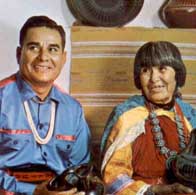Da, Popovi

Popovi Da (1922-1971) was the youngest son of Julian and Maria Martinez. He was named Antonio Jose Martinez at birth but changed that legally to Popovi Da (Red Fox) in 1948.
He grew up learning how to make pottery with his parents while he attended the San Ildefonso Pueblo school, then Santa Fe Indian School.
Among his fellow students at SFIS were Harrison Begay, Quincy Tahoma, Allan Houser, Pablita Velarde and Andy Tsihnahjinnie. It was in their company that he developed really fine technical skills as a painter, jeweler and watercolor artist creating works featuring wildlife, geometric designs and abstract symbolism.
Popovi was drafted by the US Army in 1944 and was stationed at Los Alamos and the Manhattan Project. After he was discharged from the Army, he and his wife Anita returned to San Ildefonso and opened the Popovi Da Studio of Indian Arts.
The Studio offered works for sale from many San Ildefonso potters and included a museum of some of the finest works by Popovi’s mother and by other fine Native American artists.
Popovi served as Director of the School of American Research, Chairman of the All-Indian Pueblo Council and served on the board of the New Mexico Arts Commission during those years. He also served six terms as Governor of San Ildefonso Pueblo.
He began painting pottery for Maria with his sister-in-law, Santana, around 1950. At first Santana would outline the designs and Popovi would fill them in. Then in 1956 Maria enrolled him in painting pots full time for her. He also took over the digging and preparing of clay as his father had done before him. He became Maria’s sole working partner and Adam and Santana went off on their own.
It was around then that Maria changed her signature from Marie to Maria. There were some pots produced in 1956 signed “Maria + Santana” but when Maria went exclusively with Popovi, they signed Maria + Popovi and later added a date. It was during those years that Popovi began working to revive the making of polychrome pottery at San Ildefonso after the pueblo’s potters had spent 40 years producing primarily black-on-black wares.
Popovi didn’t make a pot on his own until 1962. It was after that that he was sometimes too busy with his own pieces, politics and religious affairs of the pueblo to paint for Maria. That was when Maria’s signature became Maria Poveka on the pieces which were undecorated. However, Popovi’s technical decorating skills were so high that his pieces made by himself and those he made with Maria are among the most valuable and most collectible of all Pueblo pottery.
Popovi was known as the Great Experimenter because he developed the techniques for producing the gunmetal and sienna finishes, both produced by manipulating the firing process. It was Popovi who also is believed to have developed the first turquoise inlay, a technique now employed by maybe 100 different potters in several different pueblos.
Sgraffito (ie: to scratch) is another technique pioneered at San Ildefonso by Popovi Da as it had never been used before on San Ildefonso pottery.
Popovi began working to revive the San Ildefonso polychrome style in 1956 and entered the first polychrome piece he was happy with in the Gallup Inter-Tribal Ceremonial in 1957. It earned the Best of Class ribbon.
In 1967 the Institute of American Indian Art presented the Three Generations show in Santa Fe, NM, and at the US Department of the Interior in Washington, DC, featuring works by Maria, Popovi and Popovi’s son Tony Da.
Since his untimely death in 1971, Popovi’s work has been featured in several major exhibitions and shows and some of his pieces are in the permanent collections of several major museums around the world, including the Smithsonian Institution in Washington, DC and the the Museum Fur Volkerfunde in Berlin, Germany.
Some Exhibits that Featured Popovi’s work
- A Century of Pueblo Painters: San Ildefonso Pueblo 1900-1999. Adobe Gallery. Santa Fe, New Mexico. March 3, 2017 – April 30, 2017. Group show and sale
- Beauty Speaks For Us. Heard Museum. Phoenix, Arizona. February 10, 2017 – March 31, 2017
- Something Old, Something New, Nothing Borrowed: New Acquisitions from the Heard Museum Collection. Heard Museum. Phoenix, Arizona. April 2, 2011 – March 18, 2012
- Choices and Change: American Indian Artists in the Southwest. Heard Museum North. Scottsdale, AZ. June 2007
- Gifts to Celebrate. Heard Museum. Phoenix, AZ. October 2005 – July 2006
- Home: Native Peoples in the Southwest. Heard Museum. Phoenix, AZ. May 2005
- The Collecting Passions of Dennis and Janis Lyon. Heard Museum. Phoenix, AZ. May 2004 – September 2004
- Masterworks by Native Peoples of the Southwest. Heard Museum. Phoenix, AZ. June 2003
- A Revolution in the Making: The Pottery of Maria and Julian Martinez. Heard Museum. Phoenix, AZ. May 2003 – September 2003
- Jewels of the Southwest. Arizona Historical Society Museum. Tempe, AZ. February 2002 – April 2002
- Images, Artists, Styles: Recent Acquisitions from the Heard Museum Collection. Heard Museum North. Scottsdale, AZ. July 2001 – December 2001
- Recent Acquisitions. Heard Museum. Phoenix, AZ. July 1997 – January 1998
- When the Rainbow Touches Down. Heard Museum. Phoenix, AZ. October 1986
- Native Peoples of the Southwest. Heard Museum. Phoenix, AZ. 1985 – 2003
- Native American Paintings: Selections from the Museum of the American Indian. Heard Museum. Phoenix, AZ. September 1982 – November 1982
- One Thousand Years of Southwestern Indian Ceramic Art. ACA American Indian Arts. New York, NY. December 1981 – 1982
- Fifth Scottsdale National Indian Arts Exhibition. Executive House. Scottsdale, AZ. March 5, 1966 – March 13, 1966